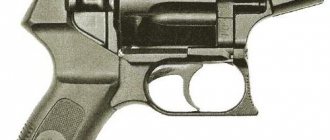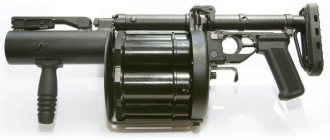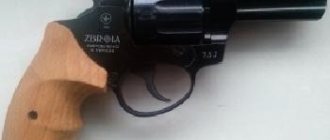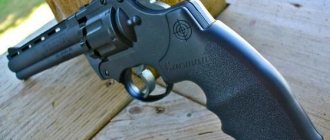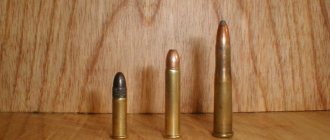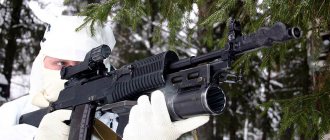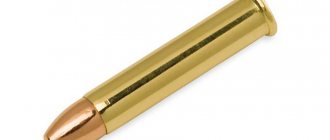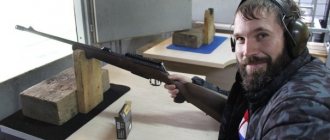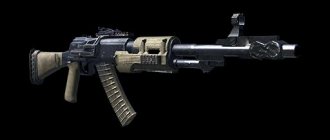Catalog/MMG pistols/revolver Bulldog
Country: USA Length: 203 mm Barrel length: 102 mm Weight: 0.7 kg Caliber: .44 (11 mm) Rifling: 5, right. Magazine capacity: 1 cartridge Initial bullet speed: 152 m/s
“Bulldogs” are usually classified as revolvers that inherited the following design features from Vebley No. 2:
- the frame, handle and barrel are made in one piece;
- the barrel is relatively short (about 2.5 inches), although long-barreled examples are also found;
- as a rule, a fairly large caliber (initially - .442, .450, etc., that is, more than 11 mm. Subsequently, “bulldogs” were produced in a variety of calibers);
- double-action trigger mechanism with open hammer;
- a short handle, in the classic “bulldog” - in the form of a parrot’s beak;
- loading and extraction - alternately, the extractor is a ramrod that retracts inside the drum axis;
- The drum door is located on the right and opens downwards.
Bulldog-type revolvers under different names (“Kobold”, “Constable”, etc.), with various variations in design, technological design and appearance were produced by many weapons manufacturers in Europe and America. In the USA they were produced, in particular, by Forehand & Wadsworth, Iver Johnson, Harrington & Richardson; in Belgium - Clement, Lepage, etc. “Bulldogs” were used as civilian and police weapons, and were even in service in the army and navy. In everyday life, any short-barreled revolver is often called a “bulldog”. Some models of modern revolvers are sold under the trade name “Bulldog” (for example, the American Charter Arms Bulldog), but in their design they are not related to the “bulldog” type revolvers described here.
4.2-line Smith-Wesson revolver
American revolver, which was created in 1869.
It became famous for being in service with the Russian Empire in the 19th century, which indicates the empire’s interest in the most modern military developments. The revolver had a breaking frame, which ensured easy removal of spent cartridges when the barrel was tilted down, a newfangled central ignition cartridge for that time, and accelerated reloading, which was achieved by the fact that the revolver could “break” in half. Weight is about 1.5 kilograms, the initial speed of the bullet is 200 meters per second. There were huge supplies to Russia, for that matter. First, 90 thousand revolvers were produced for our country, which were successfully used in the Russian-Turkish war. Later, Russia received the opportunity to organize the production of these weapons at the Tula Arms Plant. By the way, the model itself was modified by Russian weapons engineers, a so-called “heel” appeared - a protrusion at the top of the rear end of the handle, in order to reduce the recoil effect, the cartridge case extraction mechanism was also modified, which made it possible to remove cartridges manually.
A short historical excursion. In 1870, Grand Duke Alexei Alexandrovich, during a trip to the United States, took part in a large bison hunt, where he managed to shoot a huge animal using this same revolver at a distance of about 30 meters. As a result of a successful hunt, the Smith & Wesson campaign received a new order from the Russian government for revolvers in the amount of 160 thousand units. This is how cooperation used to be.
Story
The company was founded in 1964 by a young gunsmith designer, Douglas McClenahan, who previously worked for Colt, High Standard and Sturm, Ruger & Co. The company's first pistol was the five-shot revolver "The Undercover" chambered for .38 Special. A special feature of its design was the absence of side plates, which were used in models by other revolver manufacturers. The one-piece body gave the new revolver strength, allowing it to be safely fired under high loads. McClenahan also reduced the number of moving parts and invented a firing pin safety device.
The company was located in Stratford (Connecticut). It went bankrupt in the 1990s, but the technology and brand were taken over by Charter 2000, a company owned by the Ecker family. As a result, production of Charter Arms revolvers was resumed in Shelton, Connecticut.
Using Charter Arms' basic design, the new company made several improvements, such as the use of a one-piece barrel and front sight. Also, the new models have increased the number of rifling in the barrel from six to eight in order to increase bullet speed, improve trajectory and increase accuracy. New models are equipped with a completely locked firing system: the pistol cannot fire unless the trigger is pulled back all the way.
In addition to resuming production of the .38 Special "Undercover" and .44 Special "Bulldog" models, Charter 2000 began producing revolvers chambered for .22 Long Rifle/.22 Magnum ("Pathfinder"), .357 magnum ("Mag Pug") cartridges. and .38 Special (“Off-Duty” and “Police Bulldog”).
In 2005, Charter 2000 announced that it was going to file for bankruptcy due to the costs associated with the many baseless lawsuits filed against the company.
In September 2005, MKS Supply took over the sales, marketing and distribution of Charter Arms products.
In 2008, a new Patriot revolver was released under the Charter Arms brand, chambered for the .327 Federal Magnum cartridge and having two modifications: with a 2.2-inch barrel length and a 4-inch stainless steel barrel. In August 2011, this model disappeared from the company's catalog.
Also announced in 2008 was the creation of a new revolver, the "Charter Arms Rimless Revolver" (CARR), designed to chamber wafer cartridges such as 9mm, .40 S&W and .45 ACP. Initially, the first deliveries of the revolver were expected in early spring, but shipments were delayed by patent problems. As a result, serial production of the CARR, later called “Pitbull,” began in August 2011. The first Pitbull models had a 2.3-inch barrel chambered in .40 S&W. This cartridge was the most common in US law enforcement, allowing the Pitbull to be used as a .40 caliber service pistol.
In October 2010, the agreement with MKS Supply ended, and the company took over the sales and marketing of its products itself.
During the 2022 SHOT Show, Charter 2000 introduced the .41 Remington Magnum “Mag Pug” and .45 Colt “Bulldog XL.”
Revolvers Charter Arms Undercover / Mag Pug / Bulldog / Pitbull (USA)
Undercover .38 Special revolver
Mag Pug Target .357 Magnum revolver
Revolver Bulldog caliber .44 Special
Charter Arms revolvers are simple and reliable weapons for self-defense and sport shooting at a low cost. Weapons under this brand have been produced in the USA since 1964. The company currently produces a wide range of revolvers, most of which are compact models for concealed carry. The first model of this manufacturer was a revolver called Undercover, which gained the greatest popularity from the entire model range of the company. Its modern version is perfect for concealed carry for self-defense purposes due to the combination of such qualities as reliability and simplicity of design, as well as small dimensions and weight.
The Undercover model fires .38 Special rounds, but Charter Arms today produces revolvers in a variety of calibers. Bulldog revolvers fire .44 Special cartridges, while Mag Pug revolvers fire .357 Magnum cartridges. Pitbull revolvers of similar design fire 9x19 and .40 S&W wafer pistol cartridges. Again, virtually identical in design, the Undercoverette revolvers fire a smaller caliber .32 H&R Magnum revolver cartridge, while the Pathfinder model fires a 5.6mm rimfire rimfire cartridge.
Charter Arms revolvers are available in a wide variety of designs, differing not only in frame material, barrel length and sights, but also in a wide range of exterior color options. In addition to the standard for black and steel weapons, both in matte and polished form, the manufacturer offers dark green, camouflage with stripes, yellow, brown, blue, cyan, gold, red and pink frame colors. Such a variety of bright and distant colors from the world of weapons is dictated by the focus of the struggle in the arms market for its female component.
Technically, Charter Arms revolvers are of fairly traditional design. The frame of the basic versions is made of steel with removable trigger guard and handle modules. The trigger mechanism is hammer type, double action, with a firing pin located in the frame. In addition to the main part of the model range with an open trigger, there are also options with a hidden trigger, such as the Undercover Lite DAO. The drum is folding to the left. The drum latch is located behind it, on the left side of the frame. In addition to standard grip cheeks, cheekpieces with a built-in laser sight from Crimson Trace are also installed. The sights for most options are non-adjustable. Target variants are equipped with micrometric rear sights.
"Bulldog" in history
Revolver Guiteau
- Charles Guiteau, who attempted to assassinate US President Garfield in 1881, used a Webley British Bulldog revolver. The mentally unstable Guiteau bought an expensive Bulldog with an ivory handle specifically for the assassination attempt, so that it would look good in a museum afterwards. Guiteau's revolver was kept in the Smithsonian Institution and was lost in the early 1900s.
- At the end of the 19th century, the import of revolvers with a very short barrel into Germany was prohibited as a “criminal” weapon. To get around this restriction, long-barreled “bulldogs” with a front sight in the middle of the barrel were manufactured and imported into the country so that the buyer could shorten the barrel himself.
- In 1878, in St. Petersburg, terrorist-populist Vera Zasulich made an attempt on the life of mayor F.F. Trepov. Zasulich was armed with a Bulldog type revolver.
Interesting facts from history
It has been historically proven that the assassination attempt on American President Garfield in 1881 was carried out using a Bulldog revolver. The performer was Charles Guiteau, who had mental disabilities. He specially purchased a pistol in an expensive design, with ivory inserts. The ill-fated revolver was kept in the Smithsonian Institution museum and went missing at the beginning of the 20th century.
Another interesting fact is that the supply of short-barreled revolvers to Germany was prohibited in the 19th century. Manufacturers have circumvented this limitation in a simple way. Specimens with long trunks equipped with a front sight in the middle were imported into the country. The client could easily shorten the barrel himself.
First modifications
A number of revolving pistols were developed by the British from the mid-nineteenth century. Manufacturers patented the first capsule models in 1853. A few years later, the famous 44-caliber Bulldog revolver appeared, the full name of which sounded like Webley No.1. The British Bulldog.
The tactical and technical parameters of this modification are presented below:
- Type - revolver with a solid frame.
- Length (total/barrel) – 159/64 millimeters.
- Caliber – 11.2 mm.
- Weight excluding the weight of cartridges – 0.45 kg.
- The drum capacity is five charges.
The first "Bulldog" - a revolver chambered for the 442 caliber centerfire cartridge, was released in 1878. Then versions appeared for 450 ammunition and a version for a rimfire charge. All surfaces of the drum-type magazine had a smooth base. In 1880, an analogue for the 32 caliber was created.
"Bulldog": traumatic revolver
This variation has become popular recently as a weapon for self-defense. Externally, it has a classic appearance; models with rubber bullets or a gas charge have been developed. Main characteristics of the Bulldog injury:
- Type - foreign-made revolver.
- The cartridge used (caliber) is 9 millimeters.
- The drum capacity is five charges.
- The shape is smooth and streamlined.
- The basis is a steel body and barrel.
- The handle has rubberized elements.
The revolver has an excellent design, is compact, equipped with a security system, and can be charged using the trigger or by self-cocking. The model is in demand due to its small size and effectiveness at close range.
Second series
The following modifications of the weapon in question are known as "Webley No. 2". The Bulldog revolver, the photo of which is below, was produced from 1879 to 1914. The pistol was a compact short-barreled device, loaded through a drum door and equipped with a shortened handle in the form of a “bird’s head”.
The starting copies had five charges and belonged to the 442 caliber. Later versions were produced for cartridges of 32.38, 44 and 45 sizes. The model was widely copied and actively sold. It is noteworthy that the only identifying mark was the inscription in the form of the name of the pistol. Manufacturer's marks were not placed on the revolvers, and it was often possible to distinguish a fake from an original only due to the lack of British markings. Considering that the modifications had minor external and structural differences, it can be assumed that many different gunsmiths took part in the development and production of this revolver.
Colt King Cobra
357 caliber, a completely different build that can shorten or lengthen the pistol by almost half. Developed in 1986 for supply to law enforcement agencies, and for ordinary shooting enthusiasts. The main material is blued and stainless steel. Although from 1986 to 1992 this Colt was made of high carbon steel, and the grips were made of neoprene. Sights consisted of a replaceable front sight, attached to the barrel with a pin, and an adjustable micrometric rear sight. The arms company was confident in its creation, but it had to curtail production of the Cobra twice. Now all the copies have ended up in someone’s hands, in private collections. The catastrophic economic situation of the Colt campaign in 1998 ended the epic of this revolver, promising in every sense.
Description
Late production Charter Arms Bulldog in .44 Special
Like most Charter Arms weapons, the Bulldog is a relatively inexpensive but serviceable, no-frills, snubnosed revolver. It was designed to be easily concealed due to its small size, but also fires "big bore" calibers. The Bulldog has no sharp edges to contend with when carrying a weapon in a holster or pocket. The Bulldog is a solid frame traditional double-action revolver with a five-round cylinder that can be opened by pressing the removable slide to the left of the gun, or in the original model, by pulling the ejector rod. It has a concave look. Its trigger, in both single and double action modes, is quite light. If there is a large amount of pile residue inside the gun due to heavy use, the valve cylinder axle screw can be removed and the cylinder pulled out of the gun for cleaning. Most critics believe that the bulldog's best use is self-defense.
Play
The bulldog's accuracy is facilitated by its trigger. Reviews say it is more accurate than expected for a revolver of its size and type, but probably not accurate enough to be called an "accurate" weapon.
When fired, the hammer does not actually hit the firing pin. Under normal firing conditions, a small steel block (called a ) is raised like a trigger, placing it in position between the striker and the hammer itself. The falling hammer hits the transmission bar, which in turn hits the firing pin, unloading the weapon. If the trigger does not pull when the hammer drops, the gear bar will not be in position and the weapon will not discharge.
ammunition
The Bulldog appears to be designed for light, fast bullets, as with heavier, slower bullets it is less accurate. In most types of ammunition, muzzle velocity is typically between 705 and 1,000 feet per second (215 and 305 meters per second, respectively). For self-defense, Blazer 200-grain (13 g) Gold Dot appears to be the load of choice for the Bulldog. If the Bulldog is used for hunting, the most effective ammunition is reported to be 240- or 250-grain (16 g) MFA. With this type of bullet, the shot is very powerful and has strong penetration, but recoil can be easily handled. Other types of ammo are weaker or provide too much recoil.
Technical characteristics of Charter Arms revolvers
Undercover
- Caliber: .38 Special
- Weapon length: 185 mm
- Barrel length: 51 mm
- Weight without cartridges: 456 g.
- Magazine capacity: 5 rounds
Mag Pug Target
- Caliber: .357 Magnum
- Weapon length: 270 mm
- Barrel length: 127 mm
- Weight without cartridges: 710 g.
- Magazine capacity: 6 rounds
Revolver Bulldog
- Caliber: .44 Special
- Weapon length: 198 mm
- Barrel length: 64 mm
- Weight without cartridges: 599 g.
- Magazine capacity: 5 rounds
Design
“Bulldogs” are usually classified as revolvers that inherited the following design features from Vebley No. 2:
- the frame, handle and barrel are made in one piece;
- the barrel is relatively short (about 2.5 inches), although long-barreled examples are also found;
- as a rule, a fairly large caliber (initially - .442, .450, etc., that is, more than 11 mm. Subsequently, “bulldogs” were produced in a variety of calibers);
- double-action trigger mechanism with open hammer;
- a short handle, in the classic “bulldog” - in the form of a parrot’s beak;
- loading and extraction - alternately, the extractor is a cleaning rod that retracts inside the drum axis;
- The drum door is located on the right and opens downwards.
Bulldog-type revolvers under different names (“Kobold”, “Constable”, etc.), with various variations in design, technological design and appearance were produced by many weapons manufacturers in Europe and America. In the USA they were produced, in particular, by Forehand & Wadsworth, Iver Johnson, Harrington & Richardson; in Belgium - Clement, Lepage, etc. “Bulldogs” were used as civilian and police weapons, and were even in service in the army and navy. In everyday life, any short-barreled revolver is often called a “bulldog”. Some models of modern revolvers are sold under the trade name “Bulldog” (for example, the American Charter Arms Bulldog), but in their design they are not related to the “bulldog” type revolvers described here.
Production Features
The weapon in question was produced under various names (“Constable”, “Kobold” and others). The pistol was made by gunsmiths in Europe and America. Its purpose is very broad. The Bulldog was a revolver used for self-defense by civilians and was used by the police, army and navy.
The mass production of this type of weapon was carried out by such well-known companies as Forehand and Woodsfor, Harrington and Richardson, Clement, Lepage and others. Often, any revolver with a shortened barrel is called a “Bulldog”. At the same time, it can differ significantly structurally and externally from classical modifications. This can be seen on some modifications of American pistols that have a charging drum.
The classic definition of this pistol is that it includes a large linear caliber, a short barrel. The bullets are fired directly from the drum, making it very effective at close range, but with rather poor lethality and accuracy at long range.
story
Designed by the founder of the original Arms Charter, Doug McClenahan, the Bulldog was released in 1973 and was one of the best-selling weapons of the 1970s and 1980s in the United States.
Its design and execution, which were quite modern at the time, attracted the attention of the pistol press and combat shooters. By the mid-1980s, over half a million units had been produced and almost 37,000 were produced each year
Production of the Bulldog has been stopped several times since 1992, when Charter Arms, the original manufacturer, went bankrupt.
After some time, production began again under the Charco (descendant of the Charter Arms company) trademark. This company also filed for bankruptcy, and the model produced during this period showed obvious manufacturing defects. It was prepared again in accordance with the 2000 Charter; this company, which failed, also improved the weapon with a solid barrel, front sights, ejector shroud assembly. The original model did not have an ejector shroud and the aluminum front sight was not soldered to the barrel.
In June 2007, a version of the Bulldog with new features began to be produced by another company called Charter Arms, but this time MKS power was distributed.
Bulldog was used by serial killer David Berkowitz aka the ".44 Caliber Killer" and "Son of Sam" who was responsible for a series of attacks and murders in New York City during 1976-1977 (before he was caught in an outstanding parking violation) .
The name "Bulldog" was a tribute to the Oringinal Webley revolver of the same name.
P.S
It can be noted that the Bulldog short-barreled revolver is a fairly effective melee weapon. At the same time, the pistol can be easily carried in a pocket or purse. These characteristics, coupled with high-quality finishes and excellent design, contributed to the development of its popularity in Europe and the United States, both among civilians and in police and army units.
Now combat modifications are used primarily as museum or memorial exhibits, since the production of suitable cartridges has practically ceased. Nevertheless, you can feel the power and beauty of the pistol in question in a pneumatic or traumatic version.
Revolver "Boxer Bulldog": device
This name applies to American models of the weapons in question. For example, Massachusetts produced three modifications of this revolver. These include:
- 32-caliber pistol with seven shots.
- Six-shot version chambered for 32 rounds.
- 44-caliber five-shooter.
All models were equipped with a solid frame, a firing mechanism with a double release, were loaded through the drum window and had alternate removal of cartridges. The handle was also made in the classic “bird” style. The markings were applied to the top of the frame.
It is also worth noting the line of revolvers from the American. Five-shot pistols (32.38 and 44 calibers) were produced here. This “Bulldog” is a non-extractor type revolver that had a solid frame, a single trigger mechanism and an open hammer.
Distinctive design features
The “Bulldog” revolver, the design of which is mostly inherited from the “Webel No. 2”, has the following distinctive features:
- the handle with the frame and barrel is a single element;
- the trunk length is no more than six centimeters, with the exception of some elongated variations;
- preference is given to large calibers, although there are versions in almost all cartridge sizes;
- the trigger part is a double-action mechanism with an open trigger;
- the shortened handle resembles a parrot's beak;
- the ramrod, which is masked inside the drum axis, acts as an extractor;
- loading the pistol - alternately;
- The drum window is located on the right side and is unlocked downwards.
The bullet speed of this weapon is about 600 meters per second, the effective sighting range is 50 meters, the rate of fire reaches 20-25 rounds per minute.
models
Five Bulldog models were produced, allowing customers to choose between: .44 Special and .357 Magnum cartridges, pistol lengths of 7.2 inches (184 mm) and 6.7 inches (171 mm) and barrel lengths of either 2.5 inches (64 mm) or 2.2 inches (56 mm). All Bulldog models have a five-shot cylinder. Currently, Charter Arms only offers its 14420, 74420 and 74421 versions. The Charter Police Undercover can also be considered a variant of the Bulldog as it is produced with the same frame model but its caliber is different and it was built to resemble a Charter disguise.
| Option | caliber | length | barrel length | Weight | Capacity | Lever | hammer |
| Model 13520 | 0.357 Magnum | 6.7 inches (171 mm) | 2.2 inches (56 mm) | 21.8 oz (620 g) | 5 cyl | Full | regular |
| Model 14420 | 0.44 Special | 7.2 inches (184 mm) | 2.5 inches (64 mm) | 21.8 oz (620 g) | 5 cyl | Full | regular |
| Model 73520 | 0.357 Magnum | 6.7 inches (171 mm) | 2.2 inches (56 mm) | 20.1 oz (570 g) | 5 cyl | Full | regular |
| Model 74420 | 0.44 Special | 7.2 inches (184 mm) | 2.5 inches (64 mm) | 20.1 oz (570 g) | 5 cyl | Full | regular |
| Model 74421 | 0.44 Special | 7.2 inches (184 mm) | 2.5 inches (64 mm) | 21.8 oz (620 g) | 5 cyl | Full | double acting only |
Links[edit]
- "14420 Bulldog, Blue Standard". Charter weapons
. - "34431 .44 Special Classic Bulldog". Charter weapons
. - "74442 0.44 Target Bulldog with 4.2" Barrel". Charter Arms
. - Williams, Dick. "Pocket Protectors". Weapons and hunting
. Archived from the original on 2008-03-12. Retrieved April 4, 2008. CS1 maint: discouraged parameter (link) - ^ B s d e Quinn, Jeff. "Charter 200044 Bulldog Pug". www.gunblast.com
. Retrieved March 11, 2008. CS1 maint: discouraged parameter (link) - ^ abcdefg Trzoneic, Stan (January 2008). "Charter Arms Bulldog Pug - Classic .44 Returns to Production, with Several CCW-Friendly Improvements". Weapons and ammunition
. Archived from the original on 2008-03-04. Retrieved March 7, 2008. CS1 maint: discouraged parameter (link) - ^ a b c d e McNab, page 74
- "Bulldog Charter 2000 Shows Why Experts Loved the .44 Special". www.gunweek.com
. Archived from the original on 2006-11-15. Retrieved October 15, 2007. CS1 maint: discouraged parameter (link) - ^ abc Chris Lucini and Norman F. Johnson. "Charter Gun Bulldog". rec.guns
. Archived from the original on 2008-03-10. Retrieved April 4, 2008. CS1 maint: discouraged parameter (link) - ^ abcd "Weapons Zone - Pug Bulldog Weapons Charter". www.thegunzone.com
. Archived from the original on 2007-08-21. Retrieved October 28, 2007. CS1 maint: discouraged parameter (link) - "MKS Supply Partners". www.mkssupply.com
. Archived from the original on 2007-10-16. Retrieved October 28, 2007. CS1 maint: discouraged parameter (link) - "David Berkowitz". www.allserialkillers.com
. Retrieved October 15, 2007. CS1 maint: discouraged parameter (link) - ^ a b c M.L. McPherson. "Charter Arms 44 Special Bulldogs: Care and Feeding". www.levergun.com
. Retrieved October 15, 2007. CS1 maint: discouraged parameter (link) - ^ abcdefgh "Bulldog Parts and Prices" (PDF). www.charterfirearms.com
. Archived from the original (PDF) on 07/08/2008. Retrieved October 15, 2007. CS1 maint: discouraged parameter (link) - ^ abcdefghi "Bulldog of Charter Guns". www.charterfirearms.com
. Archived from the original on 2007-10-14. Retrieved October 15, 2007. CS1 maint: discouraged parameter (link) - "Police undercover from statutory weapons". www.charterfirearms.com
. Archived from the original on 2007-10-11. Retrieved October 25, 2007. CS1 maint: discouraged parameter (link)
Smith & Wesson Model 29
A double action revolver chambered for the 44 magnum cartridge. A very cool thing that was created in 1955. In reality, this weapon is more for style than for purpose. The big gun that every cowboy wants to have to feel stronger. The most powerful frame available from Smith & Wesson and a very powerful cartridge. The trunk can reach incredible lengths, for example, the longest is more than 8 inches, which is approximately 24 centimeters. The recoil is pretty brutal. If you purchased this revolver, be prepared for strong impacts during shots, from this we conclude that good aimed shooting will be a very difficult task. But this revolver is not loved for its technical characteristics. Have you seen the movie "Dirty Harry"? There, Clint Eastwood's hero does not rely on anyone, only on the destructive power of his Magnum. Clumsy brutality, which forces criminals to retire quickly and painfully - that’s what was required from this revolver.
